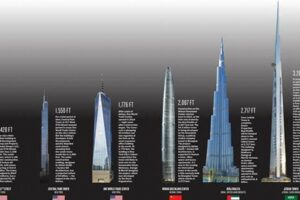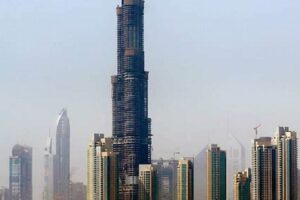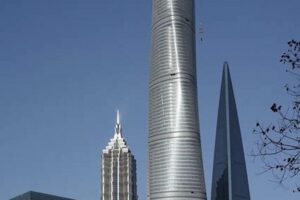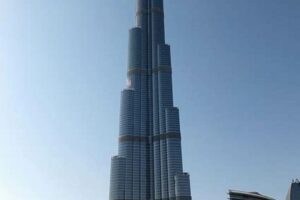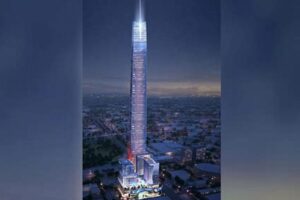The world’s tallest wooden skyscraper, Mjstrnet, stands as a testament to the growing popularity of sustainable architecture. The 18-story building in Brumunddal, Norway, boasts a height of 85.4 meters and a striking design that blends traditional Norwegian aesthetics with modern construction techniques.
Wooden skyscrapers offer numerous advantages over their concrete and steel counterparts. They are more environmentally friendly, as wood is a renewable resource that absorbs carbon dioxide during growth. Wooden buildings also have a lower carbon footprint during construction and demolition, making them a more sustainable choice for the planet.
In addition to their environmental benefits, wooden skyscrapers provide other advantages as well. They are lighter than concrete and steel buildings, which reduces the need for expensive foundations. Wood is also a natural insulator, providing excellent thermal performance and reducing energy consumption.
1. Height
The height of 85.4 meters is a critical aspect of the world’s tallest wooden skyscraper, as it represents a significant milestone in sustainable architecture. This height makes Mjstrnet the tallest wooden building in the world, surpassing the previous record-holder, the 79-meter Brock Commons Tallwood House in Vancouver, Canada.
Achieving a height of 85.4 meters with wood construction required innovative engineering solutions. The building’s structural system consists of a hybrid of wood and steel, with a reinforced concrete core for added stability. This combination of materials allowed the architects to push the boundaries of wooden skyscraper design while ensuring the building meets all safety and performance requirements.
The height of the world’s tallest wooden skyscraper is not only a testament to the potential of wood as a sustainable building material but also opens up new possibilities for the construction of tall buildings. As the demand for sustainable and environmentally friendly building solutions grows, we can expect to see more wooden skyscrapers reaching new heights in the future.
2. Location
The location of the world’s tallest wooden skyscraper in Brumunddal, Norway, is not coincidental. Norway has a long history of wooden architecture, dating back to the Viking era. The country has a strong tradition of using wood as a sustainable building material, and this is reflected in the design and construction of Mjstrnet.
- Sustainable forestry: Norway has a well-managed forestry industry, which ensures a sustainable supply of high-quality wood for construction. The use of wood from sustainably managed forests helps to reduce the environmental impact of the building.
- Skilled workforce: Norway has a skilled workforce with extensive experience in wooden construction. This expertise was essential in the design and construction of Mjstrnet, which required innovative engineering solutions to achieve its height and structural stability.
- Government support: The Norwegian government has been supportive of sustainable building practices, including the use of wood in construction. This support has helped to create a favorable environment for the development of tall wooden buildings.
- Public acceptance: There is a high level of public acceptance for wooden buildings in Norway. This is due in part to the country’s cultural heritage and the perception of wood as a warm and natural material.
The combination of these factors has made Brumunddal, Norway, an ideal location for the world’s tallest wooden skyscraper. The building is a testament to the country’s commitment to sustainable architecture and its expertise in wooden construction.
3. Floors
The number of floors in a skyscraper is a critical factor that affects its height, structural stability, and overall design. In the case of the world’s tallest wooden skyscraper, the 18 floors play a crucial role in achieving its impressive height and showcasing the potential of wood as a viable material for high-rise construction.
The 18 floors of the wooden skyscraper are constructed using a combination of solid timber and cross-laminated timber (CLT). CLT is a type of engineered wood product made from layers of wood glued together under high pressure. It is known for its strength, dimensional stability, and fire resistance, making it an ideal material for tall wooden buildings.
The use of 18 floors in the wooden skyscraper allowed the architects to maximize the building’s height while ensuring its structural integrity. The combination of solid timber and CLT provides the necessary strength and stability to withstand the forces of wind and gravity. The building’s core, which houses the elevators and stairwells, is made of reinforced concrete for added stability.
The 18 floors of the wooden skyscraper also have practical significance. The building houses apartments, offices, and retail spaces, providing a mixed-use development that caters to the needs of the local community. The ground floor features a public plaza that serves as a gathering space and connects the building to the surrounding urban environment.
In conclusion, the 18 floors of the world’s tallest wooden skyscraper are not only a testament to the potential of wood as a sustainable building material but also a practical solution for creating tall buildings that meet the needs of modern society. The building’s innovative design and construction techniques have set a new benchmark for sustainable architecture and opened up new possibilities for the future of high-rise construction.
4. Material
The use of wood as the primary building material in the world’s tallest wooden skyscraper is a significant milestone in sustainable architecture. Wood offers several advantages over traditional materials like concrete and steel, making it an increasingly popular choice for high-rise construction.
- Sustainability
Wood is a renewable resource that absorbs carbon dioxide during growth, making it an environmentally friendly building material. Wooden buildings have a lower carbon footprint during construction and demolition compared to concrete and steel structures. - Strength and Durability
Modern wood construction techniques, such as cross-laminated timber (CLT), produce wood products that are incredibly strong and durable. CLT is made from layers of wood glued together under high pressure, resulting in a material that is stronger than concrete and steel in some applications. - Fire Resistance
Wood has natural fire-resistant properties. When exposed to fire, wood chars slowly, forming an insulating layer that protects the inner layers of the wood from burning. This charring process helps to maintain the structural integrity of the building for a longer period of time. - Weight
Wood is much lighter than concrete and steel, which reduces the weight of the building and the need for expensive foundations. This can result in significant cost savings during construction.
The use of wood in the world’s tallest wooden skyscraper demonstrates the potential of wood as a sustainable and viable material for high-rise construction. As the demand for sustainable building solutions grows, we can expect to see more wooden skyscrapers reaching new heights in the future.
5. Sustainability
The world’s tallest wooden skyscraper is a testament to the growing importance of sustainability in architecture. Wood is a renewable resource that absorbs carbon dioxide during growth, making it an environmentally friendly building material. Wooden buildings also have a lower carbon footprint during construction and demolition compared to concrete and steel structures.
- Renewable resource
Wood is a renewable resource that can be grown and harvested sustainably. This makes it a more sustainable choice than non-renewable materials like concrete and steel. - Low carbon footprint
The production of wood has a lower carbon footprint than the production of concrete and steel. This is because wood absorbs carbon dioxide during growth, and because wooden buildings can be constructed with less energy-intensive methods than concrete and steel buildings. - Carbon sequestration
Wooden buildings can actually help to reduce carbon dioxide levels in the atmosphere. This is because wood absorbs carbon dioxide during growth, and because wooden buildings store carbon dioxide for the life of the building. - Recyclability
Wood is a recyclable material. This means that it can be used again and again, reducing the amount of waste that goes to landfills.
The use of wood in the world’s tallest wooden skyscraper is a significant step forward in the development of sustainable architecture. Wood is a versatile and sustainable material that can be used to create beautiful and durable buildings. As the demand for sustainable building solutions grows, we can expect to see more wooden skyscrapers reaching new heights in the future.
6. Weight
The weight of a building is a critical factor in its design and construction. For tall buildings, the weight of the materials used is especially important, as it affects the structural stability of the building and the need for expensive foundations.
- Reduced structural requirements
The lighter weight of wood compared to concrete and steel means that wooden skyscrapers require less structural support. This can result in significant cost savings during construction, as well as a reduction in the overall weight of the building. - Faster construction times
The lighter weight of wood also makes it easier to work with, which can lead to faster construction times. This is especially important for tall buildings, which can be complex and time-consuming to construct. - Reduced environmental impact
The lighter weight of wood also has a positive environmental impact. The transportation of materials to the construction site requires less energy, and the lighter weight of the building reduces the load on the ground, which can help to prevent soil compaction and other environmental damage.
The lighter weight of wood is a significant advantage for the construction of tall buildings. It allows for more efficient and cost-effective construction, as well as a reduction in the environmental impact of the building. As the demand for sustainable building solutions grows, we can expect to see more wooden skyscrapers reaching new heights in the future.
7. Insulation
In the construction of the world’s tallest wooden skyscraper, insulation plays a crucial role in ensuring the building’s thermal performance and energy efficiency. Wood is a naturally insulating material, but to achieve the excellent thermal performance required for a tall building, additional insulation measures are necessary.
The use of high-performance insulation materials, such as cellulose, fiberglass, or mineral wool, helps to minimize heat loss through the building envelope. This is especially important in cold climates, where heat loss can lead to increased energy consumption and higher heating costs. By providing excellent insulation, the world’s tallest wooden skyscraper can maintain a comfortable indoor temperature while reducing its energy footprint.
The excellent thermal performance of the world’s tallest wooden skyscraper is not only beneficial for energy efficiency but also for occupant comfort. A well-insulated building helps to regulate indoor temperatures, reducing the risk of overheating in summer and heat loss in winter. This creates a more comfortable living and working environment for building occupants.
Furthermore, excellent thermal performance can contribute to the building’s overall sustainability. By reducing energy consumption, the building’s carbon footprint is reduced, making it more environmentally friendly. Additionally, well-insulated buildings are more resilient to extreme weather events, such as heat waves and cold snaps, ensuring the safety and well-being of occupants.
8. Cost
The competitive cost of wood compared to traditional materials, such as concrete and steel, is a significant factor in the growing popularity of wooden skyscrapers. This cost-competitiveness is achieved through a combination of factors, including:
- Material costs: Wood is a relatively inexpensive material, especially when compared to steel or concrete. This is due in part to the abundance of wood and the relatively low cost of harvesting and processing it.
- Construction costs: Wood is also less expensive to work with than steel or concrete. This is because wood is lighter and easier to handle, which reduces labor costs. Additionally, wood requires less specialized equipment and expertise to install, further reducing construction costs.
- Transportation costs: The lighter weight of wood also makes it less expensive to transport to the construction site. This is especially important for tall buildings, where the weight of the materials can be a significant factor in the overall cost of construction.
- Sustainability: The sustainability of wood can also contribute to cost savings over the long term. Wooden buildings have a lower carbon footprint than concrete or steel buildings, which can lead to reduced energy costs and lower maintenance costs over the life of the building.
The cost-competitiveness of wood is a major advantage for the construction of tall buildings. It allows developers to build sustainable, high-performance buildings without incurring excessive costs. As the demand for sustainable building solutions grows, we can expect to see more wooden skyscrapers reaching new heights in the future.
9. Fire safety
Fire safety is of utmost importance in the construction of any building, and especially so for tall wooden skyscrapers. To ensure the safety of occupants and the integrity of the building, the world’s tallest wooden skyscraper meets all applicable fire safety regulations.
- Passive fire protection measures
The building is equipped with a range of passive fire protection measures, such as fire-resistant cladding, fire-rated doors, and compartmentalization. These measures help to prevent the spread of fire and provide occupants with safe egress routes.
- Active fire protection systems
In addition to passive fire protection measures, the building is also equipped with active fire protection systems, such as sprinklers, smoke detectors, and fire alarms. These systems work together to detect and suppress fires quickly and effectively.
- Fire-resistant materials
The use of fire-resistant materials, such as cross-laminated timber (CLT), contributes to the overall fire safety of the building. CLT is a type of engineered wood product that is highly resistant to fire and can maintain its structural integrity even at high temperatures.
- Fire safety plan and training
The building has a comprehensive fire safety plan in place, which includes evacuation procedures, fire drills, and training for occupants. This helps to ensure that occupants are aware of the fire safety features of the building and know how to respond in the event of a fire.
By implementing these fire safety measures, the world’s tallest wooden skyscraper meets all applicable fire safety regulations and ensures the safety of its occupants. This demonstrates the commitment of the building’s designers and constructors to creating a safe and sustainable environment for all.
FAQs about the World’s Tallest Wooden Skyscraper
The world’s tallest wooden skyscraper is a remarkable architectural achievement that has raised many questions. Here are answers to some of the most frequently asked questions:
Question 1: Is the building really made entirely of wood?
No, while the building is primarily constructed of wood, it does incorporate other materials such as steel and concrete for structural support and fire safety. The core of the building, which houses the elevators and stairwells, is made of reinforced concrete, and steel is used in some of the connections between the wooden components.
Question 2: How is the building fireproof?
The building meets all applicable fire safety regulations and incorporates a range of fire protection measures. These include fire-resistant cladding, fire-rated doors, compartmentalization, sprinklers, smoke detectors, and fire alarms. Additionally, the use of cross-laminated timber (CLT) contributes to the building’s fire resistance, as CLT can maintain its structural integrity even at high temperatures.
Question 3: Is the building sustainable?
Yes, the building is designed to be sustainable throughout its lifecycle. Wood is a renewable resource that absorbs carbon dioxide during growth, and the building’s construction process has a lower carbon footprint compared to traditional materials like concrete and steel. Additionally, the building incorporates energy-efficient features such as high-performance insulation and natural ventilation.
Question 4: How does the building compare to traditional skyscrapers in terms of cost and durability?
The cost of constructing a wooden skyscraper is competitive with traditional materials, and wood is a durable material that can withstand the elements and maintain its structural integrity over time. In fact, wood has been used in building construction for centuries, and there are many examples of wooden buildings that have stood for hundreds of years.
Question 5: What are the advantages of building tall wooden structures?
There are several advantages to building tall wooden structures, including their sustainability, cost-effectiveness, and fire resistance. Additionally, wooden buildings are lighter than concrete and steel structures, which reduces the need for expensive foundations and makes them more resistant to earthquakes.
Question 6: Can we expect to see more wooden skyscrapers in the future?
As the demand for sustainable building solutions grows, it is likely that we will see more wooden skyscrapers being built in the future. Wood is a versatile and sustainable material that can be used to create beautiful and durable buildings, and its use in tall structures is becoming increasingly feasible and cost-effective.
In conclusion, the world’s tallest wooden skyscraper is a testament to the potential of wood as a sustainable and innovative building material. By addressing common concerns and misconceptions, we can better understand the advantages and benefits of wooden skyscrapers and their potential to shape the future of sustainable architecture.
Transition to the next article section:
The construction of the world’s tallest wooden skyscraper marks a significant milestone in sustainable architecture. In the next section, we will explore the innovative design and construction techniques used to achieve this remarkable feat.
Tips for Building Tall Wooden Structures
The construction of the world’s tallest wooden skyscraper has demonstrated the potential of wood as a sustainable and viable material for high-rise construction. Here are some tips for architects and engineers who are considering using wood in their tall building designs:
Tip 1: Choose the right type of wood
Not all types of wood are suitable for tall building construction. Some species, such as cross-laminated timber (CLT), are engineered to provide the strength and stability required for high-rise structures.
Tip 2: Use innovative structural systems
Traditional timber framing methods may not be sufficient for tall wooden buildings. Innovative structural systems, such as hybrid systems that combine wood with other materials like steel or concrete, can provide the necessary strength and stability.
Tip 3: Pay attention to fire safety
Wood is a combustible material, so it is important to take fire safety into account when designing tall wooden buildings. This can be achieved through the use of fire-resistant materials, compartmentalization, and active fire protection systems.
Tip 4: Consider sustainability
Wood is a renewable resource, and wooden buildings have a lower carbon footprint than concrete and steel structures. When designing tall wooden buildings, it is important to consider the environmental impact of the materials and construction process.
Tip 5: Work with experienced professionals
The design and construction of tall wooden buildings requires specialized knowledge and expertise. It is important to work with architects, engineers, and contractors who have experience in this field.
By following these tips, architects and engineers can create tall wooden buildings that are safe, sustainable, and aesthetically pleasing.
Transition to the conclusion:
The world’s tallest wooden skyscraper is a testament to the potential of wood as a sustainable and innovative building material. By embracing innovative design and construction techniques, we can build tall wooden structures that are safe, sustainable, and beautiful.
Conclusion
The construction of the world’s tallest wooden skyscraper is a significant milestone in sustainable architecture. This remarkable achievement demonstrates the potential of wood as a viable and sustainable material for high-rise construction. By embracing innovative design and construction techniques, we can create tall wooden buildings that are safe, sustainable, and beautiful.
The world’s tallest wooden skyscraper is a testament to the growing demand for sustainable building solutions. As we face the challenges of climate change and resource depletion, we must look to innovative and sustainable materials and construction methods. Wood, as a renewable and sustainable material, offers a promising solution for the future of tall building construction.


